Zoom Meetings, launched in 2013, quickly became a key player in digital communication, amassing 200 million meeting minutes in its first year. Its usage soared during the COVID-19 pandemic, reaching 300 million daily meeting participants in April 2020.
However, by September 2025, Zoom’s market capitalization had declined from its October 2020 peak of $159 billion to $25.04 billion, amidst fierce competition from platforms like Google Meet and Microsoft Teams.
Still a significant force in the virtual communication field, this article explores Zoom’s 2025 user statistics, highlighting its resilience and current standing in a highly competitive market.
Zoom Stats: Top Picks
- Zoom has 192,600 enterprise customers.
- Zoom generated $1.217 billion in revenue last quarter ending in July 2025.
- Zoom has 4,274 customers that contribute more than $100K each in annual recurring revenue.
- Zoom’s Phone segment reached 7 million paid user seats.
- The Zoom mobile app has been downloaded 34.92 million times in Q3 2024.
Zoom Revenue
According to the company earnings release, Zoom brought in $1.217 billion in the latest quarter ending July 2025.
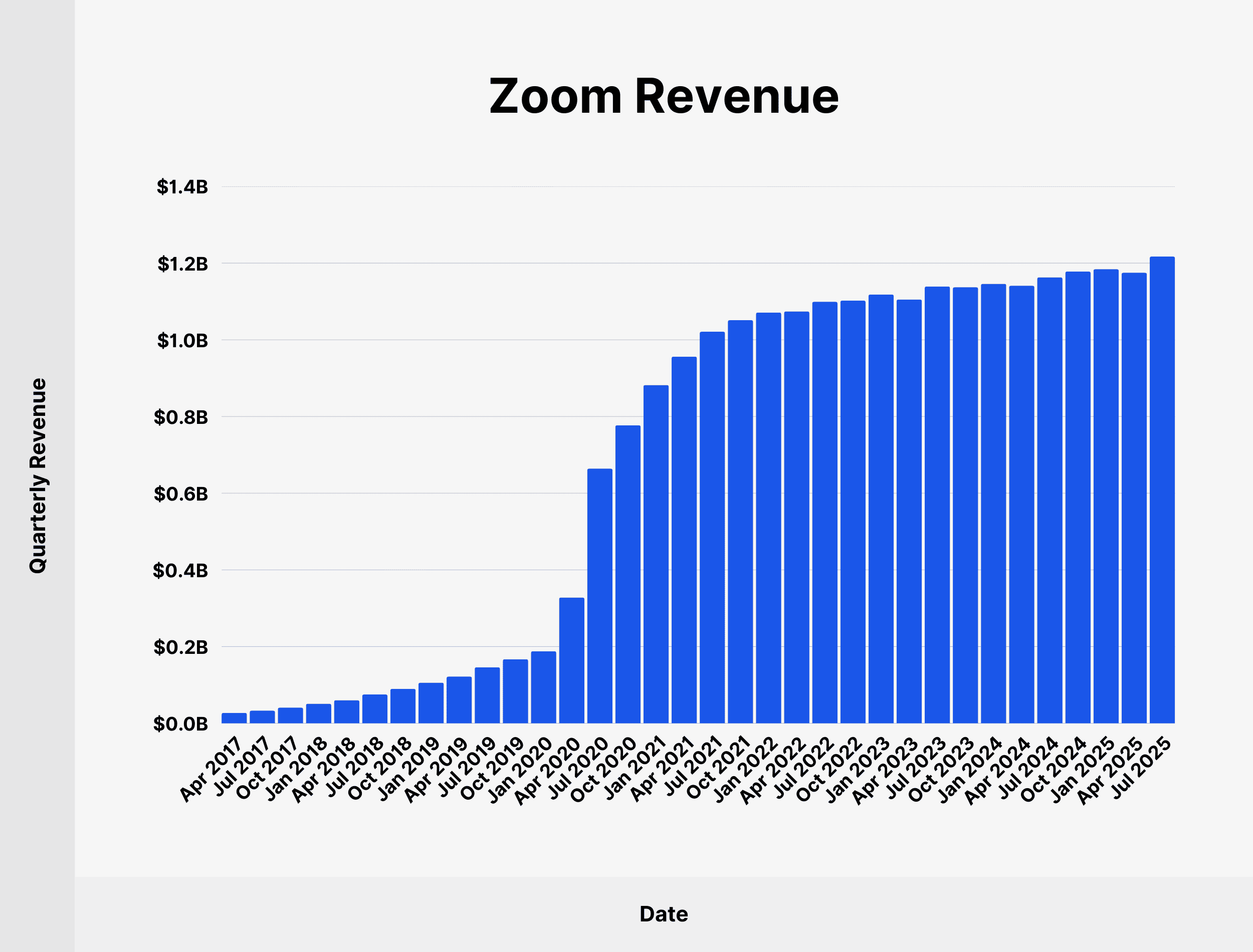
Since the pandemic and remote work adoption, Zoom revenue has grown significantly but remains relatively stable over the past 4 years.
Here’s a table with Zoom’s quarterly revenue growth since April 2017:
| Date | Quarterly Revenue |
|---|---|
| April 2017 | $27 million |
| July 2017 | $33 million |
| October 2017 | $41 million |
| January 2018 | $51 million |
| April 2018 | $60 million |
| July 2018 | $75 million |
| October 2018 | $90 million |
| January 2019 | $106 million |
| April 2019 | $122 million |
| July 2019 | $146 million |
| October 2019 | $167 million |
| January 2020 | $188 million |
| April 2020 | $328 million |
| July 2020 | $664 million |
| October 2020 | $777 million |
| January 2021 | $882 million |
| April 2021 | $956 million |
| July 2021 | $1.021 billion |
| October 2021 | $1.051 billion |
| January 2022 | $1.071 billion |
| April 2022 | $1.074 billion |
| July 2022 | $1.099 billion |
| October 2022 | $$1.102 billion |
| January 2023 | $1.118 billion |
| April 2023 | $1.105 billion |
| July 2023 | $1.139 billion |
| October 2023 | $1.137 billion |
| January 2024 | $1.146 billion |
| April 2024 | $1.141 billion |
| July 2024 | $1.163 billion |
| October 2024 | $1.178 billion |
| January 2025 | $1.184 billion |
| April 2025 | $1.175 billion |
| July 2025 | $1.217 billion |
Sources: Zoom, Macrotrends
Zoom Enterprise Customers
Zoom discloses the number of enterprise customers as a key business metric in its SEC filings.
Zoom defines enterprise customers as “distinct business units who have been engaged by either our direct sales team, resellers, or strategic partners”.
Zoom had 192,600 enterprise customers as of January 2025. Zoom revenue from enterprise customers accounted for 60% of total company revenue in the latest quarter (Q2 FY 2026).
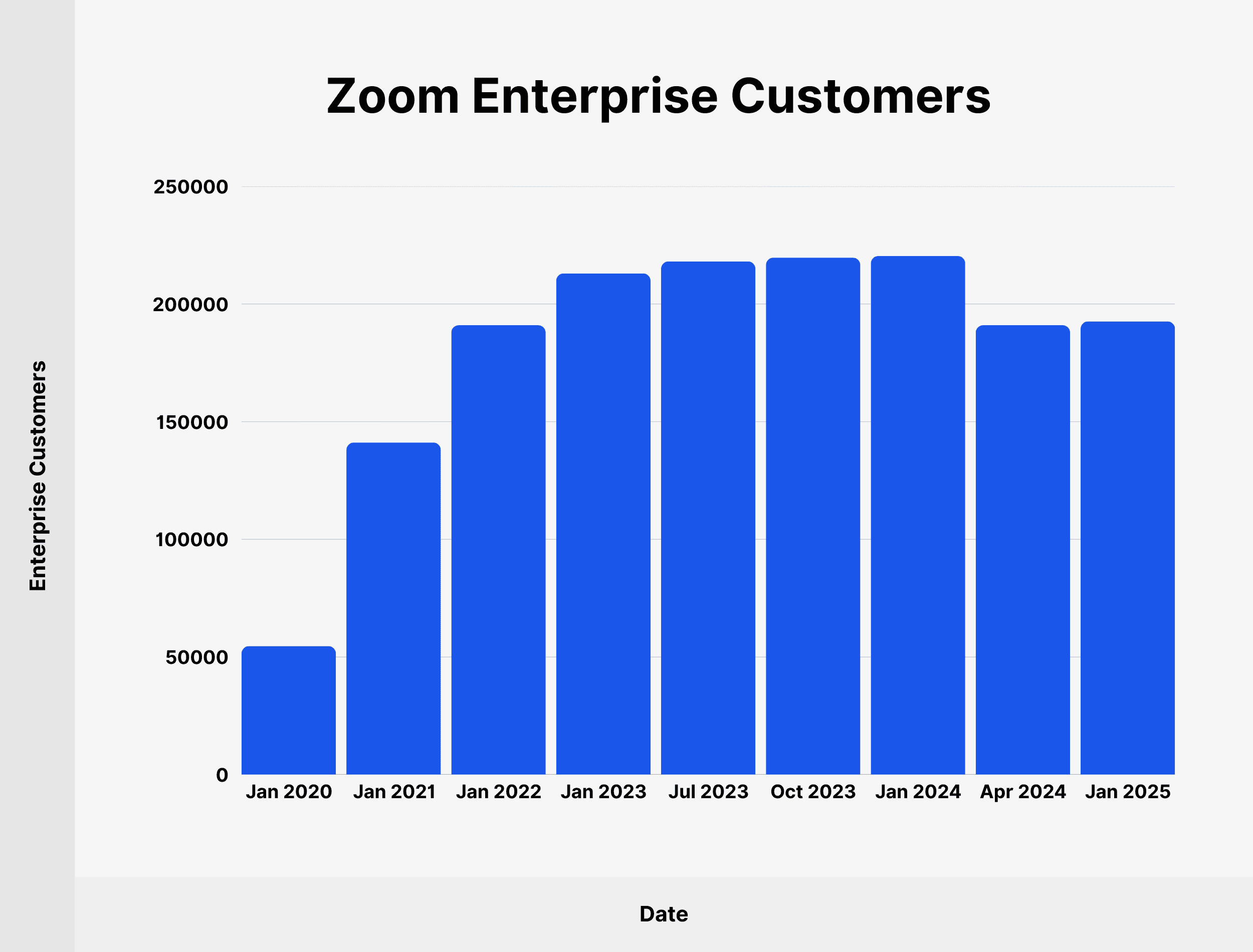
Here’s a table with number of enterprise customers over time since January 2020:
| Date | Enterprise Customers |
|---|---|
| January 2020 | 54,600 |
| January 2021 | 141,100 |
| January 2022 | 191,000 |
| January 2023 | 213,000 |
| July 2023 | 218,100 |
| October 2023 | 219,700 |
| January 2024 | 220,400 |
| April 2024 | 191,000 |
| January 2025 | 192,600 |
Source: Zoom
Zoom Customers Contributing More than $100K
Zoom had 4,274 business customers contributing more than $100,000 each per year as of July 2025.
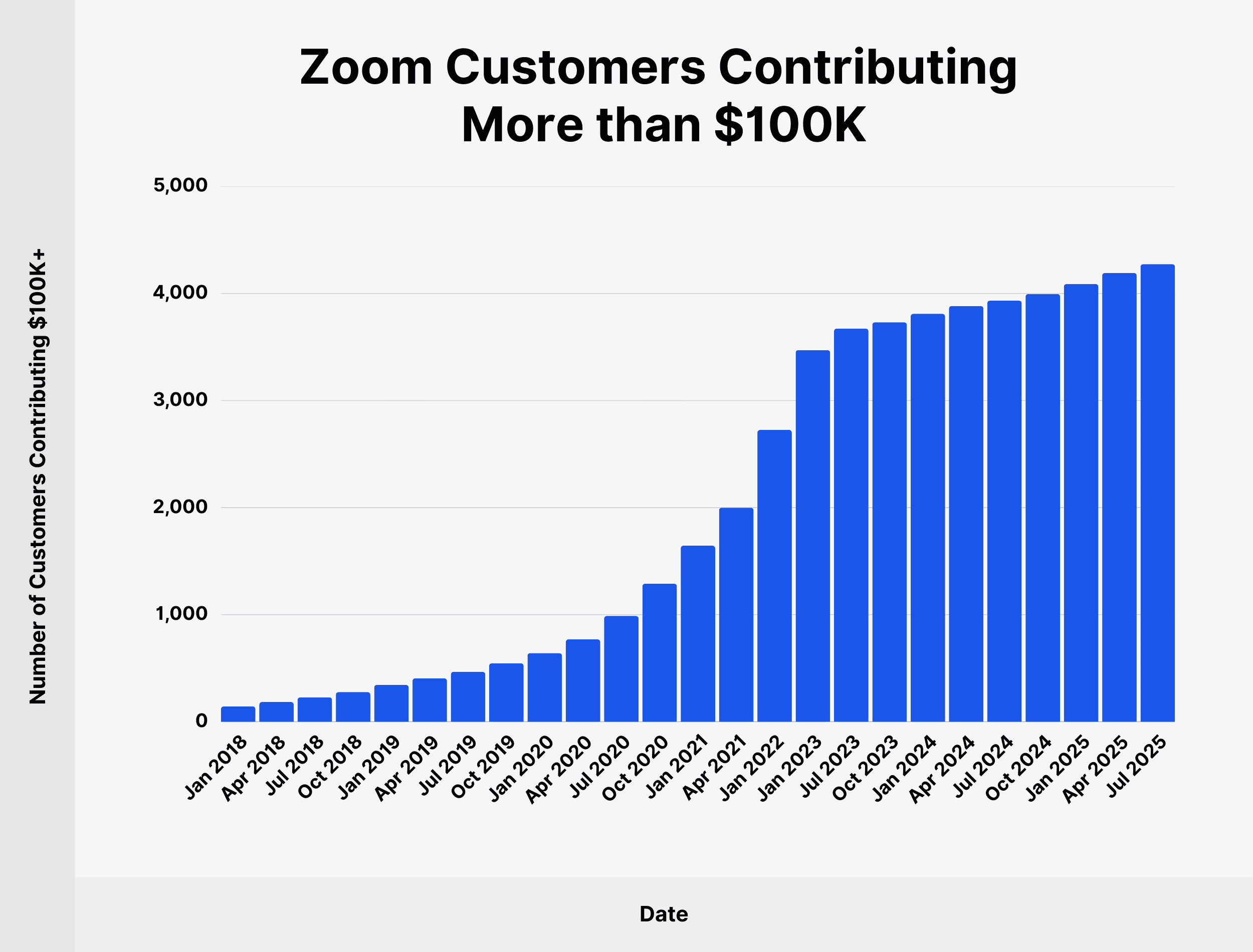
The number of $100K+ business customers is up 8.67% since July 2024.
As of July 2025, 32.2% of Zoom’s quarterly revenue comes from organizations that contribute more than $100,000 each.
We’ve prepared a table charting the growth of the Zoom client base since contributing more than $100K+ since January 2018:
| Date | Number of Customers Contributing $100K+ |
|---|---|
| January 2018 | 143 |
| April 2018 | 184 |
| July 2018 | 228 |
| October 2018 | 277 |
| January 2019 | 344 |
| April 2019 | 405 |
| July 2019 | 466 |
| October 2019 | 546 |
| January 2020 | 641 |
| April 2020 | 769 |
| July 2020 | 988 |
| October 2020 | 1,289 |
| January 2021 | 1,644 |
| April 2021 | 1,999 |
| January 2022 | 2,725 |
| January 2023 | 3,471 |
| July 2023 | 3,672 |
| October 2023 | 3,731 |
| January 2024 | 3,810 |
| April 2024 | 3,883 |
| July 2024 | 3,933 |
| October 2024 | 3,995 |
| January 2025 | 4,088 |
| April 2025 | 4,192 |
| July 2025 | 4,274 |
Source: Zoom
Zoom Phone Users
Zoom Phone launched in January 2019 as a cloud phone system available as an extension to Zoom’s platform.
Zoom has approximately 7 million Zoom Phone paying user seats, a milestone it reached in less than five years. That’s an increase from nearly 4 million seats sold as of July 2022.

As of February 2024, Zoom had 95 Zoom Phone customers with 10K+ seats.
Sources: Zoom 1, Zoom 2, Zoom 3
Number of Apps & Integrations on the Zoom App Marketplace
The Zoom App Marketplace was launched in October 2018. The app distribution platform is populated with native and third-party integrations designed to enhance the Zoom video conferencing experience.
Zoom has over 3,055 apps and integrations available for download on the Zoom App Marketplace (as of September 2025).

Source: Zoom
Zoom App Downloads
Based on data from AppMagic, the Zoom mobile app was downloaded 34.92 million times worldwide in Q3 2024 alone across the App Store & Google Play combined.
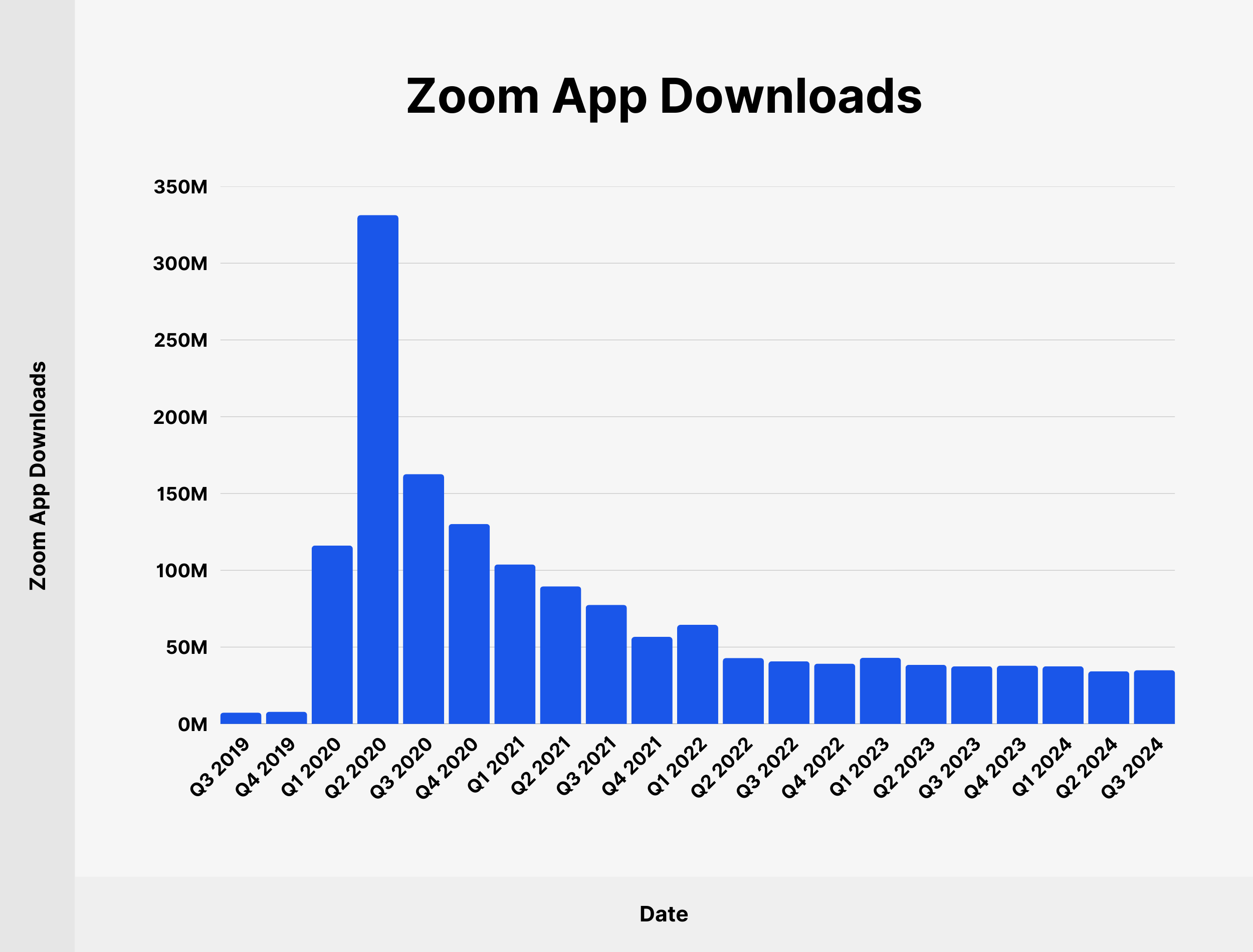
Zoom hit an all-time high of quarterly downloads during Q2 2020 (following remote work adoption caused by the pandemic), when the app was downloaded 331.32 million times.
Here’s a table with Zoom quarterly app downloads since Q3 2019:
| Date | Zoom App Downloads |
|---|---|
| Q3 2019 | 7.33 million |
| Q4 2019 | 7.86 million |
| Q1 2020 | 116.14 million |
| Q2 2020 | 331.32 million |
| Q3 2020 | 162.61 million |
| Q4 2020 | 130.19 million |
| Q1 2021 | 103.77 million |
| Q2 2021 | 89.57 million |
| Q3 2021 | 77.48 million |
| Q4 2021 | 56.65 million |
| Q1 2022 | 64.48 million |
| Q2 2022 | 42.87 million |
| Q3 2022 | 40.7 million |
| Q4 2022 | 39.18 million |
| Q1 2023 | 43.07 million |
| Q2 2023 | 38.41 million |
| Q3 2023 | 37.43 million |
| Q4 2023 | 37.87 million |
| Q1 2024 | 37.46 million |
| Q2 2024 | 34.2 million |
| Q3 2024 | 34.92 million |
Source: Statista
How Many People Work at Zoom?
Worldwide, 7,412 full-time employees work at Zoom. Zoom’s employee count has decreased by 12.64% since 2023.
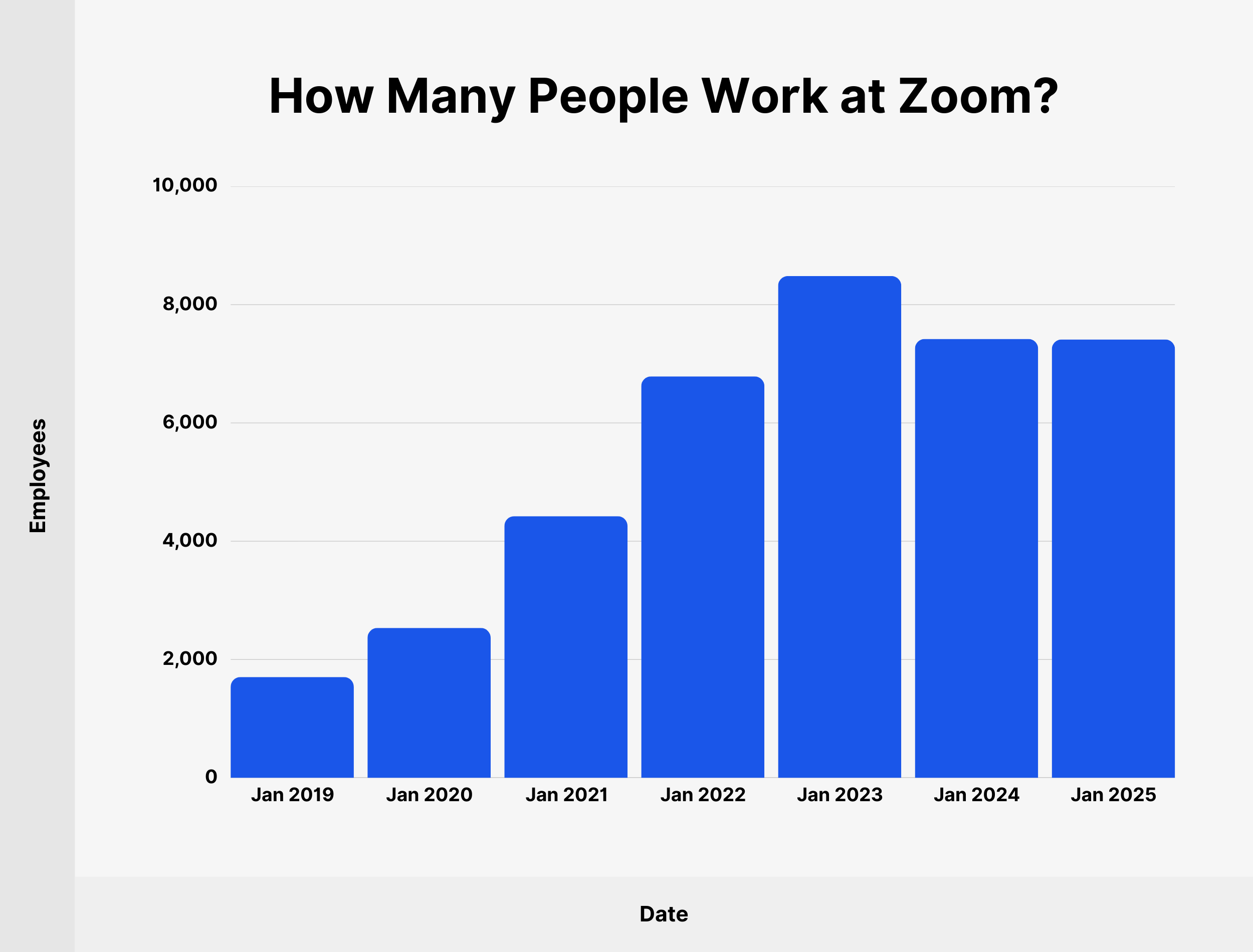
Here’s a table showing the Zoom employee count since 2019:
| Date | Employees |
|---|---|
| January 2019 | 1,702 |
| January 2020 | 2,532 |
| January 2021 | 4,422 |
| January 2022 | 6,787 |
| January 2023 | 8,484 |
| January 2024 | 7,420 |
| January 2025 | 7,412 |
The median compensation package for software engineers at Zoom totals $224,000. Zoom employees working in the US on an H1-B visa receive a median base salary of $136,600.
Sources: Macrotrends, Levels.fyi, H1B Salary Database
Conclusion
That’s it for our list of Zoom user statistics.
I hope you’ve learned something new from this stats roundup.
Backlinko is owned by Semrush. We’re still obsessed with bringing you world-class SEO insights, backed by hands-on experience. Unless otherwise noted, this content was written by either an employee or paid contractor of Semrush Inc.

